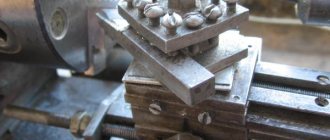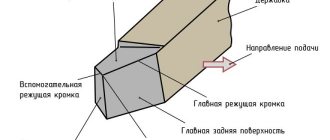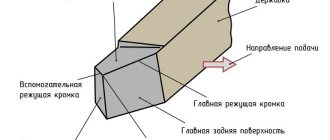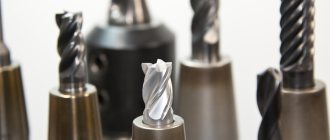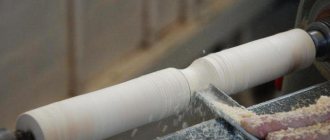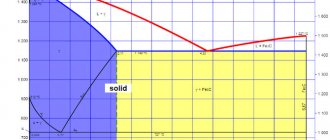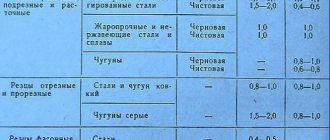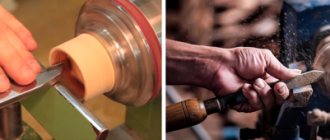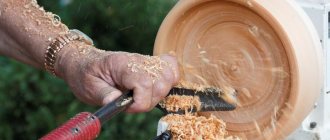When performing turning, a cutter with one or two cutting edges is mainly used. The machined surface is the surface obtained after removing chips from the workpiece. Thus, as a result of processing the workpiece, a part with complex surfaces of various shapes is obtained.
The work process consists of several stages - longitudinal turning, working with ends, as well as processing the profile part of the workpiece. In production, it is important to achieve good labor efficiency indicators. Therefore, the rational selection of cutting modes and tooling for equipment is a task assigned to the shoulders of the turner.
Design features of turning tools
Each turning tool consists of two parts.
- Holder. Can be square or rectangular. With its help, the cutter is secured in the mounting sockets of the machines. GOST establishes the following standard dimensions of holders. Square - 4*4, 6*6, 8*8, 10*10, 12*12, 16*16, 20*20, 25*25, 32*32, 40*40 mm.
- Rectangular - 16*10, 20*12, 25*16, 25*20, 50*25, 40*32, 50*32, 50*40, 63*50 mm.
Image #1: Lathe cutter design
Cutting planes
The angular parameters of a cutting turning tool are calculated using a system of coordinate planes, among which the basic planes are the main plane, the cutting plane and the main secant plane. Their mutual inclination forms the sharpening angles of the cutting part, ensuring turning in design modes. In this way, the following angles are determined: the main front (γ), the main back (α), the sharpening angle (β), as well as a number of other angles.
Cutter angles
The operation of a turning tool during the cutting process is determined by the angular parameters of the front and rear surfaces. Therefore, the main angles of the incisor are the main anterior (γ) and the main rear (α). By increasing the first, power consumption for cutting is reduced, chip control is improved and roughness is reduced. On the other hand, as the rake angle increases, the thickness of the blade decreases, which leads to a deterioration in its strength characteristics, increased chipping and a decrease in the rate of heat dissipation. The main purpose of the clearance angle is to reduce friction between the cutting surface and the main clearance. In addition to the main functional angles α and γ, the calculation determines several more angles, whose values affect the class of turning cleanliness, the process of chip formation and other technical characteristics.
Depending on the purpose
Here we are most often talking about the materials being processed.
For wood
Woodworking tools are sold by stores in the following sets:
- Combs.
- Rings.
- Hooks.
- Oblique incisors.
- Trimming cutters.
- Chisels.
- Reiers.
- Meysel.
The cutters and rotary mechanisms are attached to each other. Traces of workpieces are determined immediately by the tools, their shapes, strength, and sharpness. This makes it easier to select the shapes of the blanks in the end. From
When choosing specific sharpening angles, they rely on the materials of the workpieces.
For working with metal
Welding and brazing of plates is the optimal choice for cutters that process metal. In production, preference is given to high-speed, hard alloys. The compositions usually contain tantalum or tungsten, titanium. High strength and affordable price have become the main advantage for the tools.
Varieties are often used in which the plates are replaceable. Then they are attached to the head using special screws or clamping elements. Mineral ceramic plates are the most convenient for further use. But then the cutter will be expensive.
Carbide alloys are used in the case of tool working surfaces:
- Tungsten.
- Titanium tungsten.
- Tantalum-tungsten-titanium.
Options with high-speed steel or its carbon variety are acceptable.
Installation of cutters is permissible on several types of machines:
- Special purpose.
- Revolving automatic.
- Slotting.
- Lathes.
- Planing.
By type of processing
Finishing
Feed at low speed. The material, which is characterized by a small thickness, is removed from the blank. A pass-through cutter is the most popular type of such tool.
Semi-finish
Many similarities with the previous variety. Only the characteristics they use are two times smaller compared to the analogue. The purpose and features of the work remain almost the same.
Dimensions and types of holders
The cutting holder has several standard sizes:
Holder for turning tool
- 16*10 - Mainly used for installation on training machines and performing simple operations.
- 20*12 - for parts of non-standard sizes.
- 25*16 - the most common size, suitable for processing most standardized metal parts.
- 32*20 - the second most popular, for larger metal blanks.
- 40*25 - rarely found on sale, mostly made to order.
The right choice of cutters for a particular job is sometimes 100% successful in metal processing. This applies to rough work and simple operations. But for the sake of fine and fine fitting, it’s worth getting hold of additional tools.
Types of cutters for a lathe and their purpose
When describing the types of turning tools, several classifying characteristics are usually used. According to its design, it is divided into two types: solid and prefabricated. In the first case, the entire product is made in the form of a monolithic bar of metal. And in the second, removable or soldered carbide plates act as the blade. According to their technological purpose, turning cutters are divided into special ones, which are used for processing various profiles and threading, and general purpose products, used for external and internal turning, cutting and end trimming. Another distinguishing feature of a turning tool is the configuration of the cutting part, which depends on its operating modes and the type of turning work. For turning hard-to-reach places, a curved cutter is usually used, which has several varieties, differing in the length of the cutting part, the shape of the bend, sharpening and purpose (cockerel, bent, reverse cutters and others).
Another classification option is the division of turning tools according to the principle of machining cleanliness. There are usually two classes here: rough and finishing. The first is intended for roughing or pre-turning operations, and the second is for finishing operations. If the rough tool, with rare exceptions, is quite the same type, then among the finishing tools there are a number of varieties with their own names. Examples include blade and radius cutters with an arcuate blade, the purpose of which is precise finishing turning. Another separate type is a diamond cutter, used for turning work on super-hard materials. A cup turning cutter with a circular cutting surface has a unique design that can work for a long time without regrinding.
In addition to the standard classification, there are many names for specific turning tools, usually reflecting the features of its design or technology of use. These include a spring cutter with a wave-shaped cutting part, which springs during turning of hard and uneven materials.
A separate category of cutting tools for lathes are planing cutters. During turning operations using them, feed is carried out on a stationary part. In this case, the allowance is not cut off, as during rotation, but is removed by planing. In this configuration, a lathe performs the same function as a planer or slotter.
Direct passes
Used for external processing of steel workpieces.
A pass-through turning cutter with a part fixed in a square-section caliper. Used when carrying out special piece operations.
Bent pass-throughs
Special equipment in which the working part is bent to the left or right. Used for trimming parts. With their help it is convenient to remove chamfers.
Thrust pass-throughs
Devices come with a straight and bent working element. Designed to work with cylindrical parts. The shape plus proper sharpening allows you to quickly remove most of the excess from the working surface of the workpiece.
Bent edges
They are equipment similar to a walk-through. However, there is a difference in the shape of the cutting edge. It is triangular, which allows for better processing.
Boring
Used for through and blind group holes, recesses, and recesses.
Threaded
They create carvings outside and inside, with a section in the shape of a trapezoid, rectangles and circles. Products can be smooth, convex or round.
For external thread
They are made of durable alloys (hardened steel, cermets), spear-shaped, allowing you to apply metric and other helical spiral lines of the required depth. Available in the three most common sizes: 25 by 16, 16 by 10 and 32 by 20 mm (the latter are relatively rare in use).
For internal thread
Relevant only for those parts that have technological holes of large cross-section. The main design feature is the presence of a serpentine head. The holders boast a significant length, necessary for the tool to penetrate deeply and carefully into the fixed workpiece during the operation. Suitable only for equipment that is equipped with a “guitar”. Their dimensions, in millimeters:
- 16 x 16 x 150;
- 20 x 20 x 200;
- 25 x 25 x 300.
Smooth
They differ from the previous version by maintaining rectangular edges.
Prefabricated
The working part of the cutter 1, into which the pin 3 is seated, a carbide plate 2 is put on it. It is secured with a wedge 5 and a screw 4. This way it is securely clamped in the cutter body.
The plates are produced in 3, 4, 5 and 6-sided versions. Advantages: reduced time for processing the part, good chip removal. Instead of sharpening, they rotate the plate.
The blades are cheaper than a whole chisel. You can place plates from different alloys on one holder in turn. Optimal for fine turning.
Cutting tools for CNC machines: types, characteristics, requirements
In order to achieve excellent performance and excellent quality of part processing, each cutting tool for CNC machines must meet certain requirements. Careful selection and preparation of the necessary tools, ensuring technical reliability, automation of the working process of a CNC machine, includes matching the high level of strength of such devices with their versatility.
For the production of cutting tools they use:
- hard alloys;
- metal ceramics;
- high-speed steel;
- synthetic materials.
Moreover, hard alloys, in turn, are also divided into several groups that differ in their operational, physical, and chemical properties:
- titanium-tantalum-tungsten;
- without tungsten;
- tungsten;
- tantalum-tungsten.
About the basic requirements for cutting tools
CNC production machines generally must use cutting fixtures that satisfy a number of conditions, such as:
- stability of cutting properties;
- correct formation and removal of chips;
- versatility of use for processing different types of parts on different types of machines;
- their rapid replacement for readjustment, processing of other parts, or changing a dull tool;
- ensuring the necessary precision in processing parts.
Attention. In some cases, the above requirements for cutting tools may not allow the use on CNC devices of those that are successfully used on conventional machines. For such modern machines, special groups of cutting, standardized devices are now allocated.
About tools used on lathes
For processing parts on lathes, the following are usually used:
- incisors;
- different types of drills;
- sweeps;
- various cutters;
- taps.
About the features of using cutters
Most often, in a conventional lathe, special cutters are used as a special cutting tool, having standard designs of an established type. Usually they are prefabricated, equipped with multifaceted special plates made of hard metals and various superhard materials (SMP).
There are certain requirements for such cutters:
- maximum use of plates that are mechanically fixed to their body to ensure constant, geometric, structural properties;
- the use of plates of the most optimal shapes, which will ensure universal operation of the tools;
- the ability to provide for all the actions of these devices in a straight or inverted position;
- allow the left-hand cutter to operate;
- guaranteeing high reliability of cutting inserts;
- correct formation of chips for their removal along special grooves made on the front sides of the plates used.
About the types of incisors
Typically, a set of cutting fixtures used by such a CNC machine contains typical cutters of this type:
- pass-through, bent on the right side by 45° to ensure chamfering, external turning of the end sides;
- contour cutters with plates in the form of a parallelogram, allowing you to turn cylindrical, contour parts, and turn conical parts up to 30°;
- contoured, with special parallelogram-shaped plates for the ability to process hemispherical surfaces and cones up to 57°;
- threaded, having rhombic plates that are fixed on top, making it possible to cut threads with a pitch distance of 2 to 6 mm.
About replaceable polyhedral plates (SMP)
Prefabricated cutters with SMP plates have gained the greatest popularity; their widespread use on CNC machines is due to such factors as:
- economical consumption of cutting scarce cutters;
- reduction of time for setting up tools, in which the change of SMP can be done without removing the cutter body;
- good quality of chip crushing;
- there is no need to constantly sharpen the cutter itself.
Dependence of cutting tool productivity on plate fastening methods
In prefabricated devices, productivity, as well as reliability, endurance, and longevity of their operation, depend on the methods of fastening multifaceted plates. These fasteners must provide:
- reliability (without possible microscopic displacements during movement made by cutting tools);
- density of surface contact between the support plates and grooves;
- precise positioning and the possibility of mutual replacement of working edges;
- support for geometric stability;
- crushing and reliable removal of chips;
- the shortest time allowed for changing blades.
About tools used for milling machines
For milling, cutters are used as cutting devices, which come in various designs and have special teeth for processing the surface of parts.
All milling tools differ from each other in:
- the shape and appearance of the teeth;
- their direction and execution;
- their use and fastening.
In order to properly strengthen the cutter in the chuck of a milling machine, use its shank, which is attached to the teeth by welding or with various fasteners, for example:
- bolts;
- special wedges;
- screws.
Sometimes the cutter can be presented as a single unit with its cutting part. That’s what they usually call it – a solid cutter.
Important. Some modern CNC machines use only one-piece special end mills that have cylindrical and also conical shanks for more durable, quick fixation in the chuck of milling machines.
The following materials are most often used in the production of milling tools:
- metal ceramics;
- high-speed cutting steels;
- hard alloys with special diamond coatings to enhance hardness.
About the principles of milling
When milling, using the teeth of a cutter, chips are removed from the surfaces they grind, and they are removed from the cutting zone by special grooves along the cutter itself. Therefore, the location of the teeth relative to each other is of particular importance. Correct geometric relative position affects:
- cutting speed;
- quality of processed surfaces;
- wear resistance of the cutter;
- saving energy costs;
- price of finished products.
Attention. Each type of intended workpiece, be it wood, stone, metal, plexiglass, for example, requires a certain type of milling device.
About the types of cutters
These instruments come in a variety of types, which are usually classified into certain groups, united by a common feature. Such signs include, for example:
- design features;
- geometric shapes;
- types of processed parts.
Design features include cutters:
- solid, made from one type of material as an indivisible whole with its own cutting side;
- compound cutters, characterized by a toothed part made of durable steel, soldered or welded to the shank;
- prefabricated, in which the toothed part is attached to the shank in a simple mechanical way (using bolts or screws).
According to their geometric type, such cutting devices include cutters:
- end;
- cylindrical type;
- end;
- conical type.
The milling operation is associated with cutting actions performed on the surfaces of various parts, for example:
- grinding surfaces;
- cutting grooves;
- cutting various types of threads;
- simple cutting of metal.
There are also standardized cutting tools, depending on the type of workpiece being processed, for example, milling cutters for processing:
- copper, aluminum and other ductile metals;
- stone;
- wood;
- plexiglass;
- become.
In such cases, the material of the cutting parts themselves on the cutters depends on the rigidity of the workpiece being processed and, accordingly, on the design of special grooves for removing chips, which can be:
- plastic;
- small;
- large;
- fragile.
About the features of selecting cutting tools
Nowadays it is difficult to imagine a modern CNC milling machine without appropriately suitable special milling tools, without which significant productivity cannot be achieved. Precision processing of parts and ease of use are the main criteria for the strict requirements placed on them.
On such machines, the cutting tools are often cylindrical end mills made of carbide or diamond materials. Their advantages include:
- possessing high wear resistance;
- ability to withstand vibration during rotational motion;
- increased rigidity;
- high cutting speed;
- very high processing accuracy.
All modern machines with numerical control can perform the most complex technological operations, automatically performing the necessary processing of parts. Moreover, the parts can be made of cast iron, light metal alloys, and steel. All actions of such devices are programmed before the start of the work process. That’s why it’s so important to choose the right cutting tools that meet all the necessary requirements and parameters.
vseochpu.ru
Geometry of turning tools
Image: geometry of a turning tool.
Let's talk about the angles of the incisors and their purposes.
- Back auxiliary angle (α1). As it decreases, the friction force between the rear plane of the tool and the workpiece decreases.
- Apex angle (ε). Formed between the cutting edge and the rear auxiliary plane. The larger this angle, the better the heat removal conditions and the higher the strength of the cutter.
- Auxiliary plan angle (ϕ1). Its size varies from 10 to 30°. As the angle decreases, the cleanliness of the treatment improves, but the friction force increases.
- Leading angle (ϕ). Its size varies from 20 to 90°. The length and width of the cut depend on the size of the angle. The smaller ϕ, the lower the temperature and cutting force. The cleanliness of the processing is also improved. But as the angle decreases, vibration and radial cutting force increase.
- Cutting angle (δ). Formed between the rake surface and the cutting plane.
- Basic rake angle (γ). Its size varies from -5 to +15°. As the angle increases, it is easier for the tool to cut into the metal, chip removal is improved, and the cutting force, deformation of the machined surface, and power consumption are reduced. However, this reduces heat dissipation and reduces the service life of the cutting edge.
- Taper angle (β). Formed between the front and main back surfaces. Affects the sharpness and strength of the tool.
- Main relief angle (α). Its size varies from 6 to 12°. As the angle decreases, the friction force between the part and the back surface of the cutter decreases. This improves heat dissipation and extends the service life of the tool, but the cleanliness of the machined surface deteriorates.
- Angle of inclination of the main cutting edge (λ). Affects the direction of chip removal. At positive λ and λ = 0°, the chips move towards the machined surface. Cutters with positive λ (12–15°) are used when processing workpieces made of heat-resistant and hardened steels. For universal turning tools, λ = 0°. Cutters with negative λ are used for finishing.
Cutting tool
All tools used in metalworking can be divided into cutting tools (cutters, drills, taps, etc.), which directly carry out machining (cutting), and auxiliary tools, which serve to secure the cutting tool in the machine spindle (chucks, holders, mandrels) .
Machine tools can have different basic spindle tapers, and the cutting tool, in turn, is made with different types of shanks.
The basic cone of the machine is the spindle exit, made in accordance with one of the standard options. There are metric cones (7:24 or ISO 7388.1), Morse cones (domestic milling machines or drilling group equipment), HSK (modern machines designed for high-speed processing).
Thus, the auxiliary tool is a kind of adapter between the machine spindle and the cutting tool. The combination of cutting and auxiliary tools is called a tool block. Note that the tool block may contain several auxiliary tools and only one cutting tool (the main one). Large tool blocks reduce the rigidity of the technological system and reduce the accuracy of installation of the cutting tool, resulting in worse processing conditions and product quality.
Rice. 2.4. Milling cutters with mechanical fastening of cutting inserts
According to technological characteristics, cutters are distinguished for processing planes, grooves and splines, gears, threads, shaped surfaces, for cutting material, etc.
By design they are distinguished:
- according to the design of the cutter (solid, composite, with insert teeth);
- according to the design of the tooth (with sharpened teeth, with backed teeth);
- in the direction of the tooth (straight, inclined, screw teeth);
- according to the method of fastening (mounted, tail-mounted - with a cylindrical or conical shank).
According to the material from which they are made: high-speed steel, carbide, etc. In modern tool practice, the lion's share is made up of solid carbide or high-speed tools, as well as tools with mechanically fastened cutting parts (plates). Hard alloys allow working with cutting speeds that are 5–10 times higher than the processing speeds of high-speed tool steels, and have greater temperature resistance and wear resistance. When choosing a cutter, the technologist is primarily guided by the following parameters:
- diameter and length of the working part;
- profile shape of the working part;
- working part material;
- number of teeth (cutting edges);
- shape and size of the fastening part.
Rice. 2.5. Solid end mills
A conventional end mill has several cutting teeth (2, 3, 4, 6 or a rectangular profile of the cutting part. The cutter teeth are separated by helical grooves, which ensure removal of chips from the cutting zone. In the case when it is necessary to obtain a transition from one surface to another with a certain radius, cutters with a ball end or a small radius at the base of the profile are used. Ball end cutters and ball end cutters are often used for machining complex surfaces, such as dies and molds. Conical cutters are used for milling inclined surfaces and undercuts.
End mills are the most versatile - they allow you to machine planes, grooves and shoulders. There are other types of cutters: face, disk, slot. These cutters, as a rule, are used to perform milling operations with a “narrow” focus. For example, a face mill is the best tool for milling an open plane, while a disk mill is best for cutting a deep, narrow slot in one pass.
Rice. 2.6. Face mill and cutting insert
Milling cutters with mechanical fastening of hard alloy plates and other tool materials have become widespread. The bodies of such cutters have special seats in which the plates are installed. Fastening the plates to the steel body is usually carried out using ordinary screws. The plates have several edges, and if one of them wears out, it is possible to rotate the plate with a “fresh” edge. When all the edges are worn out, the plate can be thrown away and a new one installed. It turns out to be a very economical solution, since solid carbide cutters are quite expensive. Modern cutting inserts are designed to withstand a variety of conditions and vary in rake geometry.
The pitch of the cutter teeth can be coarse, normal or fine. Milling cutters with different tooth pitches are designed for different machining conditions in terms of stability, energy consumption and the presence of vibration. A reduced number of plates is a standard solution for productive processing with insufficient machine power or low rigidity of the AIDS system (machine - fixture - tool - part). Normal pitch cutters are universal for most operations. A small pitch or the maximum number of plates on a cutter body of a given diameter is recommended for processing with high rigidity of the AIDS system, as well as when milling materials that produce elemental chips, titanium and heat-resistant alloys.
The thickness of the cut layer during milling is affected by the leading angle, which is measured between the main cutting edge of the insert and the machined surface. Reducing the entering angle results in thinner chips for a given feed range. The reduction in chip thickness occurs due to the distribution of the same volume of metal removed over a larger length of the cutting edge. At a smaller approach angle, the cutting edge gradually enters and exits the work. This reduces the radial component of the cutting force and protects the cutting edge from possible breakage. On the other hand, an unfavorable factor is an increase in the axial component of the cutting force, which causes a deterioration in the surface roughness of thin-walled parts.
At an entering angle of 90°, the cutting force is directed radially in accordance with the feed direction. The main area of application for such cutters is the processing of rectangular shoulders.
Rice. 2.7. Leading angle 90°
When working with a milling cutter with a 45° entering angle, the axial and radial cutting forces are almost identical and the power consumption is low. These are cutters for universal use. They are especially recommended for processing materials that produce elemental chips and are prone to chipping under significant radial forces at the tool exit. When plunging the tool, there is less load on the cutting edge and less tendency to vibration when secured in fixtures with low clamping forces. The smaller thickness of the cut layer at a cutting angle of 45° allows you to increase the minute feed of the table, that is, increase processing productivity.
Mills with a leading angle of 10° are recommended for longitudinal milling with high feeds and plunge milling, when small chip thicknesses and high speed parameters are characteristic. The advantage of processing with such cutters is low radial cutting forces. And also the predominance of the axial component of the cutting force in both radial and axial feed directions, which reduces the tendency to vibration and provides great opportunities for increasing material removal rates.
Rice. 2.8. Leading angle 45°
For cutters with round inserts, the leading angle varies from 0 to 90° depending on the depth of cut. These cutters have a very strong cutting edge and can operate at high feed rates because they produce fairly thin chips over a long cutting edge length. Round insert cutters are recommended for machining difficult-to-cut materials such as titanium and heat-resistant alloys. The direction of cutting forces varies along the radius of the insert, so the direction of the total load depends on the depth of cut. The modern geometry of round inserts makes them more versatile, providing a stable cutting process, lower power consumption and, accordingly, lower requirements for equipment rigidity. Currently, these cutters are widely used for removing large volumes of metal.
Rice. 2.9. Round insert cutters
planetacam.ru
Cutters for lathes - what to look for
When choosing this metal-cutting tool, you need to pay attention to the following basic parameters:
- material and geometry of the cutting part;
- chip breaking method;
- strength and vibration resistance of cutting edges and holder;
- shape and dimensions of a removable or welded plate;
- geometry, design and roughness of the plate socket;
- durability and dimensional stability of the cutter;
- cutter angles;
- ensuring the specified roughness of the processed surface.
Dependence of cutting tool productivity on plate fastening methods
In prefabricated devices, productivity, as well as reliability, endurance, and longevity of their operation, depend on the methods of fastening multifaceted plates. These fasteners must provide:
- reliability (without possible microscopic displacements during movement made by cutting tools);
- density of surface contact between the support plates and grooves;
- precise positioning and the possibility of mutual replacement of working edges;
- support for geometric stability;
- crushing and reliable removal of chips;
- the shortest time allowed for changing blades.
Marking according to GOST
Requirements for the production of metalworking machines, as well as auxiliary equipment, are strictly regulated by the requirements of interstate standards.
There are much fewer requirements for the rods of cutting devices compared to the elements of the contact group. They are made from steel grade 45 or 50.
There is a separate standard for each type of design. For example, the production of cutters with upper clamping of a replaceable plate is regulated by GOST 26611-85.
In the production of high-speed steel plates, cobalt compounds are used:
- R9K5;
- R9K10;
- R18F2K5.
After heat treatment, their hardness reaches 67 HRC.
There are special requirements for the surface roughness of devices. After finishing the front and rear parts, the degree of cleanliness must correspond to class 9.
Symbols in accordance with the requirements of the interstate standard are applied to the side surface.
As an example, let's decipher the T15K6 marking:
- "T". The first letter indicates that a solid composition of the titanium group was used as the manufacturing material.
- "15". The number indicates the mass fraction of titanium carbide in the product.
- "TO". The product contains cobalt.
- "6". Mass fraction of the above chemical element.
Tool classification
There are many parameters for classifying cutters in accordance with current GOSTs. According to the design features, the following types of turning tools are distinguished:
- monolithic, in which the cutting head and holder are a solid structure;
- prefabricated ones, in which a high-speed alloy plate is soldered on the head, providing increased processing efficiency - this is one of the most common types of tools;
- prefabricated, with a mechanically fixed plate - the plate is fixed on the head by a bolt; in this configuration, cutters with metal-ceramic plates are made;
- adjustable.
Functionality of cutters
Depending on the quality of processing, turning tools are divided into roughing and finishing. The geometry of the roughing tool allows for the removal of thick material and maintains hardness under the intense heat that occurs at high processing speeds. Finishing analogues have a different purpose; they are needed to work at low speeds to remove a small thickness of material.
The tool is also classified according to the feed direction, according to which right and left cutters are distinguished. The feed direction refers to the side on which the main cutting edge of the tool is located at the moment when its head is facing the front of the workpiece.
Types of incisors
Functional purpose is one of the main classification parameters of this tool. According to their purpose, turning tools are divided into:
- Cutting (GOST No. 18874-73) - used on machines with transverse feed of working tools, intended for sheathing and processing of the end parts of workpieces.
- Pass-through (GOST No. 18871-73) - can be installed on machines with both transverse and longitudinal feed. They are used for trimming ends, turning, forming parts of conical and cylindrical shapes.
- Cutting, also known as groove (GOST No. 18874-73) - mounted on machines with transverse feed. Used for cutting monolithic pieces of metal and turning ring-shaped grooves.
- Boring (GOST No. 18872-73) - designed for boring holes (through and blind), forming recesses and recesses.
- Shaped (GOST 18875-73) - used to remove external and internal chamfers.
- Threaded (GOST No. 18885-73) - allow you to cut threads of metric, inch and trapezoidal sections (both internal and external).
Also, turning cutters are divided into straight, bent and drawn depending on the position of the cutting edge in relation to the holder. In bent ones the edge is made in the form of a straight line, in bent ones it is curved, in drawn ones the edge is narrower than the width of the rod.
Which cutters to choose, where to buy?
To determine which cutters are needed specifically in your case, you need to decide on the following points:
- what metal you will process and what operations will be performed;
- prioritize quality, processing efficiency and tool wear resistance.
In general, a novice turner needs to have three types of cutters at his disposal: passing (marked SDACR) - for processing ends, external neutral type (SDNCN) and boring (SDQCR). This is a basic kit that allows you to perform most technological operations.
If you are interested in buying a tool for long-term use, it makes sense to buy a set of turning tools with replaceable inserts. Subsequently, you will be able to change consumables rather than buy new holders after the cutting head wears out.
A few words about the manufacturers. Among the companies that sell really high-quality products that are worth buying, we highlight the companies Hoffman Garant (Germany) and Proma (Czech Republic). In the segment of domestic manufacturers, the companies SiTO (Gomel Tool Plant) and Kalibr deserve attention. You can order cutters with delivery using the links provided.
It also makes sense to purchase a sharpening machine that will allow you to return the cutters to their functionality when worn out yourself, rather than using the services of third-party craftsmen. Here you need a sharpening and grinding unit equipped with a constant cooling system with two abrasive wheels - made of silicon carbide (for cutters made of high-speed alloys) and electrocorundum (for carbide tools). When sharpening, it is initially necessary to process the front plane of the cutting head, then the additional and rear ones, until a smooth cutting edge is formed.
Cutting tools for CNC milling machines
Milling cutters are used as cutting tools on CNC milling machines. Despite the design diversity, each cutter has cutting blades (teeth) that interact with the workpiece surface being processed. The cutter shank is used to secure it in the machine chuck. The shank can be attached to the toothed part by welding (or other fasteners - screws, bolts, wedges, etc.), or be a single unit with the cutting part (then the cutter is called solid). In high-speed automatic CNC machines, preference is given to solid end mills with a cylindrical or conical shank for quick and reliable mounting in the spindle chuck. The materials used for the manufacture of cutters are high-speed steel, cermets, and diamond-coated hard alloys.
Processing principle
When the tool interacts with the workpiece, the cutter teeth remove chips from the surface being processed. Special grooves along the cutter body help remove chips from the cutting area. It is not difficult to guess that the relative position of the teeth and their geometry have a decisive influence on the quality of surface treatment, cutting speed and wear resistance of the cutter itself. And also on the amount of losses due to friction and heating, and, consequently, energy costs for processing and the final cost of the finished product. Therefore, special cutters are used for each type of workpiece (wood, metal, plastic, plexiglass or stone).
Types of cutters
Various types of cutters can be classified into groups using one of the following characteristics as a basis.
By design features:
• Solid – when the cutter shank and its cutting part are made as a single unit from the same material;
• Composite cutters feature a durable tooth part (tool steel) welded to a structural steel shank. This group also includes cutters with teeth made of tool steel soldered onto the body;
• Prefabricated - as noted above, the toothed part of such cutters is mechanically attached to the shank.
By geometry:
• Cylindrical;• Face;• End;• Conical;• Engraving;• Diamond;• Worm, etc. Depending on the type of workpiece being processed, there are specialized cutters for wood, steel, ductile metals (copper, aluminum), plexiglass or stone, and etc. In this case, the differences mainly concern the material of the cutting part of the cutter (depending on the hardness of the workpiece), as well as the design of the grooves for removing chips (based on the nature of the chips - plastic, brittle, large or small, etc.).
Tool features for modern CNC machines
The main advantages of automated machine tools are their high productivity, processing accuracy and ease of use. Ensuring this is impossible without the use of an appropriate tool, which also has strict requirements. To work on CNC machines, cylindrical end mills - carbide or diamond - are mainly used. Such cutters have increased rigidity and wear resistance, resist vibration during rotation and provide high accuracy and cutting speed. The designs of cutters are quite varied. Below are the most common types with features and applications.
| Cutting tool type | Design features | Processed material | Note |
| End single-thread | One cutting edge, inclined sharpening | Hard or viscous materials (plastic, acrylic, etc.) | Optimized for high speed processing; provide low roughness of the processed surface |
| End two-start | Two cutting edges, sharp tooth | Brittle materials that form small chips (wood, plexiglass, “composites”, some types of plastic) | Good at removing small chips, but the thickness of material removed in one pass is limited |
| Spiral single-start | One cutting edge, inclined sharpening | Plastics, PVC, acrylic | Designed for high-speed processing; The shape of the groove is specially designed for the formation of long chips - in order to self-clean the cutter and increase its durability. According to the hardness class, types N, A, AA are distinguished. |
| Spiral double-start spherical | Two cutting edges, rounded tooth shape (“spherical”) | They are used for engraving (text, drawing) and finishing complex 3D objects containing many small parts. | Low vibration during processing – provide a smooth processing surface; When finishing wood, the surface is polished. |
| Conical spherical | Needle-shaped, pointed, with a rounded end | MDF, wood, hard steel | Combines high strength with a small diameter working surface |
| Conical engraver | The cutting part is flat, conical | They are used for precision machining of small elements (usually parts of complex three-dimensional objects). | In terms of strength, engravers are distinguished between N and A, although both types are extremely wear-resistant |
| V-shaped engraver | Characteristic triangular end | Surfaces of any materials, including hard metal | Used for applying so-called V-engraving |
It should be noted that there is no single generally accepted classification of cutters - each manufacturer uses its own designations. However, the above list can be used as a general guide. Of course, it is far from complete. For a specific case, it is necessary to select a cutter depending on the material and type of the finished product, the type of machine and processing modes. It should be remembered that proper selection of a cutter will ensure high quality milling, reduce energy costs for processing, and therefore the cost of the final product.
infofrezer.ru
Making your own cutters: a step-by-step guide
The main thing is to use only tool steel that has sufficiently high performance characteristics.
Experts recommend choosing an alloy or high-speed carbon version.
Selecting the required configuration of files or rasps
The selection of these parts will be easier if the owner knows in advance exactly what tasks he faces. After this, choosing the length, shape and size will not be difficult. Here are some tips.
- If you need to file up to 5-10 mm in thickness, it is better to stop at cut number 0 or 1.
- The processing accuracy should be within 0.01-0.02 mm.
- It is much easier to choose devices based on length.
The main guideline is the dimensions of the surface that needs to be sawed. The larger this parameter, the larger the device itself should be.
You can use a specific formula to make the calculation more accurate. We add 15 cm to the length of the surface of the product. We get the value, which will be the length of the working surface of the file or rasp. The main thing is that when working, the tool is passed over the entire workpiece.
Fastening cutting parts
Homemade tools do the same as professional ones. The optimal solution is self-tapping screws. The higher quality the product, the better.
How to install a parting cutter
In order to perform cutting correctly without increased wear of the cutting plate, as well as to ensure the required quality of the end after cutting, it is necessary to align the cutter strictly perpendicular to the part. In addition, it must be installed opposite the axis of rotation with a vertical deviation of no more than ± 0.1 mm. Placing the edge of the blade even a few tenths of a millimeter higher can cause the cutting blade to break, and placing it too low can leave an uncut step on the workpiece. Cutting must be done as close to the chuck jaws as possible, using a cutter with a minimum overhang.
To facilitate the processing of complex materials on desktop machines, spring and inverted cutters are used. But, probably, craftsmen use other designs for these purposes, as well as various improvements to “standard” cutters. If you know anything about this, please share information in the comments to this article.
Operating rules
Turning cutters are capable of performing their main function for a long time until the working surface is ground down. But improper use will shorten the life of the tool. To prevent preliminary wear, you need to follow simple operating rules:
- Install centrally.
- The larger the dimensions of the workpiece, the larger the cutter should be.
- Turn on cooling when operating in heavy conditions.
- Sharpen in a timely manner.
- Periodically polish the working surfaces with a fine-grained stone without removing the tool from the tool holder.
- Apply the tool to the workpiece manually, and after touching, turn on the automatic feed.
- When stopping the machine, first manually retract the tool, then turn off the unit.
- Select the correct cutting modes.
- Do not store the tool in a pile - this will lead to chips and cracks on the cutting edge.
- When working with a cutting tool, bring it as close to the chuck as possible.
Many types of work are performed on a lathe. A separate cutter is provided for each process. It is selected based on the material being processed, cutting conditions, cleanliness and roughness parameters. The tool must be sharpened in a timely manner, and the rules of operation and storage must be followed.
Quality of metalworking and type of turning tool
The main criterion when evaluating metal parts is the quality and accuracy of execution. They directly depend on the selection of cutters for turning. Therefore, tooling has a strict purpose in terms of the quality of turning work performed:
Turning of parts is carried out by cutting with a cutter
- Roughing (roughing).
- Semi-finish.
- Finishing.
- High precision operations.
Finishing and semi-finishing are used for finishing almost finished products and turning work at low speed, as well as high-precision ones. Roughing of metal takes place at maximum speed, allowing you to remove thick chips and speed up the manufacturing process of the part, but it has low quality and a short service life.
In fact, it is important to choose not only the correct cutter, but also the direction of feed. Instruments of any type are divided into right and left. That is, in the process they are fed from right to left or vice versa. It is quite simple to distinguish them: the right hand is placed on the tool, lying with the cutting surface down: if the cutting edge remains on the side of the thumb - the right hand, the left hand and the edge under the thumb - the left.
Another difference between metal turning tools that affects quality is the installation method:
- radial;
- tangential.
The first ones are widespread, cheap, equipped with simple fastenings and are installed on the machine at a right angle. They perform the bulk of tasks in any workshop. The latter have a complex fastening and are placed at an angle to the workpiece (not 900). They allow you to work more cleanly and efficiently, and are installed on automatic machines or CNC units.
Sets of cutters with other parameters
Cutters for a metal lathe 8x8 mm from the Czech company Proma are represented by eleven tools. By means of soldering, they are equipped with carbide plates. The cutter sizes in this set are 80 mm and 125 mm.
Those who need a tool with a tail section of 0.12 cm for work can use cutters for a 12x12 mm metal lathe. A wide range of work can be performed using the following cutters:
- pass-through bent;
- persistent;
- threaded;
- boring;
- cutting;
- slotted and other types of cutters.
In the modern tool market, a wide range of different products for metalworking equipment is available to the consumer. For a beginner who has decided to purchase a set of cutters for a metal lathe, experts recommend that they familiarize themselves in detail with the classification of these tools, carefully study their design features and characteristics, so that they do not have to regret their purchase in the future.
Parting and Grooving Tool Models in SolidWorks
As mentioned in earlier articles, 3D models of a cutting tool can, of course, be built from scratch in SolidWorks. But I think there is no point in this since the tool manufacturers have already done this for us.
We go to the website, and for example, download two models of cutters under the designations: “RAG123H10-32B” , “RF123H13-2525BM” .
Sandvik coromant website
And in the search line, enter these designations one by one and download the cutters by clicking on “Download” in the “download detailed 3D model” line.
Downloading a 3D model of the tool from the Sandvik coromant website
Next, open the downloaded files and get 3D models of these cutters in SolidWorks.
Internal grooving cutter RAG123H10-32B
Parting and grooving cutter RF123H13-2525BM
As you can see, this is much easier and faster than creating a cutter in SolidWorks from scratch.
If anyone needs this model, you can download it at the end of the article!

